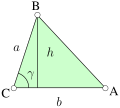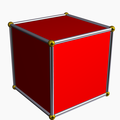Top Qs
Timeline
Chat
Perspective
Edge (geometry)
Line segment joining two adjacent vertices in a polygon or polytope From Wikipedia, the free encyclopedia
Remove ads
In geometry, an edge is a particular type of line segment joining two vertices in a polygon, polyhedron, or higher-dimensional polytope.[1] In a polygon, an edge is a line segment on the boundary,[2] and is often called a polygon side. In a polyhedron or more generally a polytope, an edge is a line segment where two faces (or polyhedron sides) meet.[3] A segment joining two vertices while passing through the interior or exterior is not an edge but instead is called a diagonal.
- A polygon is bounded by edges; this square has 4 edges.
- Every edge is shared by three or more faces in a 4-polytope, as seen in this projection of a tesseract.
An edge may also be an infinite line separating two half-planes.[4] The sides of a plane angle are semi-infinite half-lines (or rays).[5]
Remove ads
Relation to edges in graphs
In graph theory, an edge is an abstract object connecting two graph vertices, unlike polygon and polyhedron edges which have a concrete geometric representation as a line segment. However, any polyhedron can be represented by its skeleton or edge-skeleton, a graph whose vertices are the geometric vertices of the polyhedron and whose edges correspond to the geometric edges.[6] Conversely, the graphs that are skeletons of three-dimensional polyhedra can be characterized by Steinitz's theorem as being exactly the 3-vertex-connected planar graphs.[7]
Remove ads
Number of edges in a polyhedron
Any convex polyhedron's surface has Euler characteristic
where V is the number of vertices, E is the number of edges, and F is the number of faces. This equation is known as Euler's polyhedron formula. Thus the number of edges is 2 less than the sum of the numbers of vertices and faces. For example, a cube has 8 vertices and 6 faces, and hence 12 edges.
Remove ads
Incidences with other faces
In a polygon, two edges meet at each vertex; more generally, by Balinski's theorem, at least d edges meet at every vertex of a d-dimensional convex polytope.[8] Similarly, in a polyhedron, exactly two two-dimensional faces meet at every edge,[9] while in higher dimensional polytopes three or more two-dimensional faces meet at every edge.
Alternative terminology
In the theory of high-dimensional convex polytopes, a facet or side of a d-dimensional polytope is one of its (d − 1)-dimensional features, a ridge is a (d − 2)-dimensional feature, and a peak is a (d − 3)-dimensional feature. Thus, the edges of a polygon are its facets, the edges of a 3-dimensional convex polyhedron are its ridges, and the edges of a 4-dimensional polytope are its peaks.[10]
Remove ads
See also
References
External links
Wikiwand - on
Seamless Wikipedia browsing. On steroids.
Remove ads





